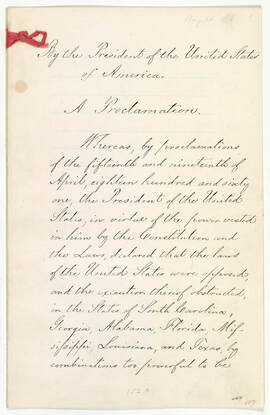 President Andrew Johnson's Proclamation of August 20, 1866 declaring an end to the American Civil War
President Andrew Johnson's Proclamation of August 20, 1866 declaring an end to the American Civil War But ask when the Civil War ended, and mostly you will get a thoughtful stare in reply. This is because most people remember being told that Lee's surrender at Appomattox on April 9, 1865 was not the end of the war. A few students of history will cite the date a month later when President Andrew Johnson, having assumed the office following the assassination of Lincoln, officially declared an end to the insurrection on May 9, 1865. Others will cite the surrender of Cherokee leader Stand Watie, who became the last Confederate general to surrender his forces on June 23, 1865. The final Confederate surrender was by the CSS Shenandoah on November 6, 1865 at the port of Liverpool, England, having sailed there from the Pacific in order to avoid internment and possible trial as commerce raiders, bringing all hostilities of the four year war to a close. But was the war over?
Well, no. despite the formal surrender of all field and navel commanders, the insurrection was not suppressed in many regions were forces of the confederacy either refused to disband or reconstituted into new insurgent forces (often little more than criminal gangs and vigilantes meting out revenge on union sympathizers and occupying forces). It was only in a presidential proclamation issued on April 2, 1866, President Johnson declared that the insurrection that had existed in Georgia, South Carolina, North Carolina, Tennessee, Alabama, Louisiana, Arkansas, Mississippi, Florida, and Virginia, was at an end. The one exception was Texas, where organized resistance still continued.
Later that summer, the President declared that the insurrection in Texas was suppressed. The President acknowledged that "adequate provisions had been made by military orders to enforce the execution of the acts of Congress, aid the civil authorities and secure obedience to the Constitution and the laws of the United States in the state of Texas."
On August 20, 1866, President Johnson issued a proclamation announcing the end of the American Civil War: "And I do further proclaim that the said insurrection is at an end and that peace, order, tranquility, and civil authority now exists in and throughout the whole of the United States of America."
With that proclamation the United States officially closed a costly, bloody, and deadly chapter in its nation's history that started at Fort Sumter several years—and hundreds of thousands lives—earlier.
 RSS Feed
RSS Feed